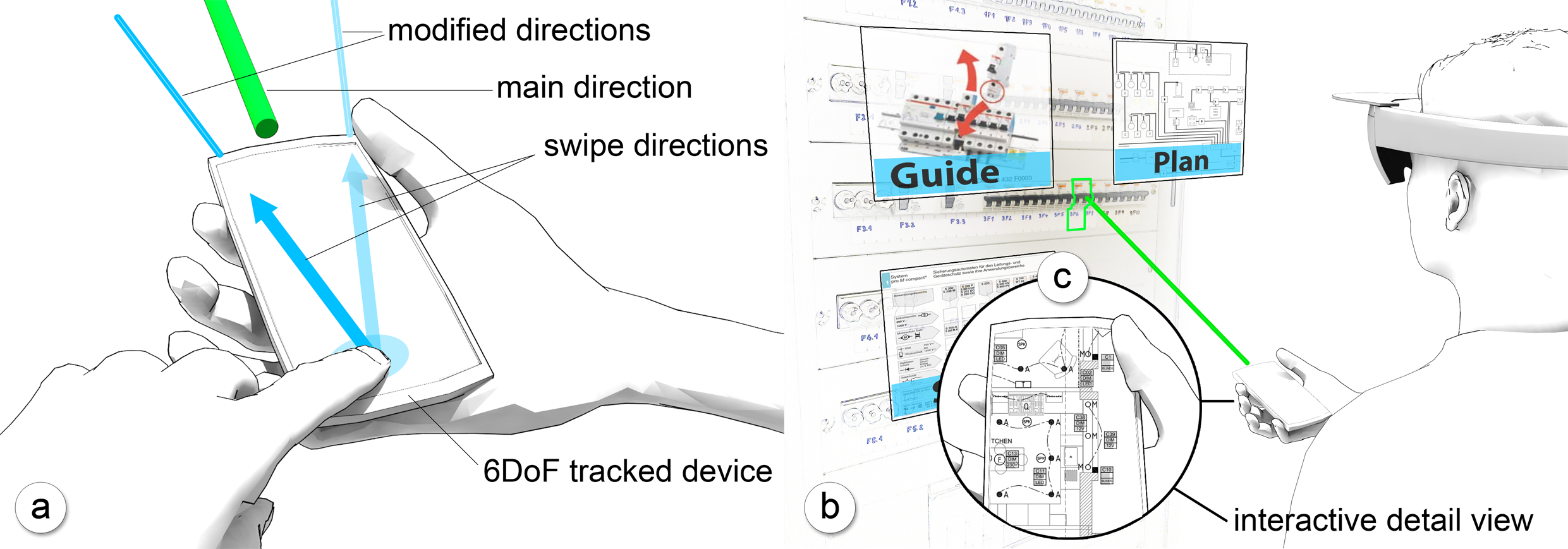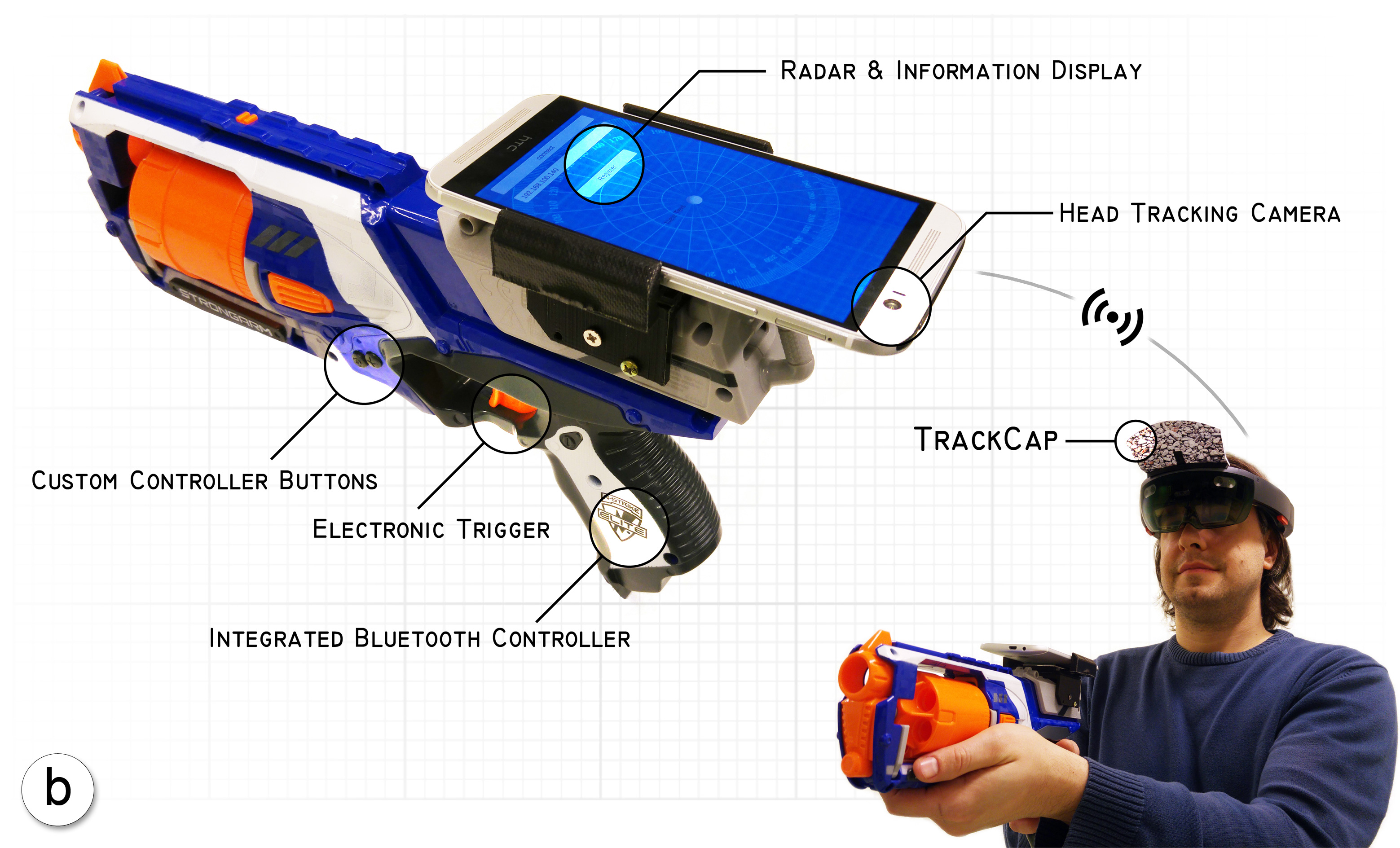TrackCap: Enabling Smartphones for 3D Interaction
on Mobile Head-Mounted Displays
Conference on Human Factors in Computing Systems (CHI 2019)

Abstract
The latest generation of consumer market Head-mounted displays (HMD) now include self-contained inside-out tracking of head motions, which makes them suitable for mobile applications. However, 3D tracking of input devices is either not included at all or requires to keep the device in sight, so that it can be observed from a sensor mounted on the HMD. Both approaches make natural interactions cumbersome in mobile applications. TrackCap, a novel approach for 3D tracking of input devices, turns a conventional smartphone into a precise 6DOF input device for an HMD user. The device can be conveniently operated both inside and outside the HMD's field of view, while it provides additional 2D input and output capabilities.
Overview
 TrackCap enables new means of interaction. For example, rays for selecting objects can be quickly
defined by swiping over the touchscreen (also see the accompanying video). (b) The high input and output fidelity of the
smartphone can also be used to display detail of the selected objects and to enable high precision interactions with them
TrackCap enables new means of interaction. For example, rays for selecting objects can be quickly
defined by swiping over the touchscreen (also see the accompanying video). (b) The high input and output fidelity of the
smartphone can also be used to display detail of the selected objects and to enable high precision interactions with them
Gamecontroller Setup

Tracked controller with high-resolution display
Citation
@inproceedings{10.1145/3290605.3300815,
author = {Mohr, Peter and Tatzgern, Markus and Langlotz, Tobias and Lang, Andreas and Schmalstieg, Dieter and Kalkofen, Denis},
title = {TrackCap: Enabling Smartphones for 3D Interaction on Mobile Head-Mounted Displays},
year = {2019},
isbn = {9781450359702},
publisher = {Association for Computing Machinery},
address = {New York, NY, USA},
url = {https://doi.org/10.1145/3290605.3300815},
doi = {10.1145/3290605.3300815},
booktitle = {Proceedings of the 2019 CHI Conference on Human Factors in Computing Systems},
pages = {1–11},
numpages = {11},
keywords = {3d pointing, mixed reality, hmd, input devices, mobile devices, augmented reality, wearable computing},
location = {Glasgow, Scotland Uk},
series = {CHI '19}
}

Tracked controller with high-resolution display
Citation
@inproceedings{10.1145/3290605.3300815,
author = {Mohr, Peter and Tatzgern, Markus and Langlotz, Tobias and Lang, Andreas and Schmalstieg, Dieter and Kalkofen, Denis},
title = {TrackCap: Enabling Smartphones for 3D Interaction on Mobile Head-Mounted Displays},
year = {2019},
isbn = {9781450359702},
publisher = {Association for Computing Machinery},
address = {New York, NY, USA},
url = {https://doi.org/10.1145/3290605.3300815},
doi = {10.1145/3290605.3300815},
booktitle = {Proceedings of the 2019 CHI Conference on Human Factors in Computing Systems},
pages = {1–11},
numpages = {11},
keywords = {3d pointing, mixed reality, hmd, input devices, mobile devices, augmented reality, wearable computing},
location = {Glasgow, Scotland Uk},
series = {CHI '19}
}
@inproceedings{10.1145/3290605.3300815,
author = {Mohr, Peter and Tatzgern, Markus and Langlotz, Tobias and Lang, Andreas and Schmalstieg, Dieter and Kalkofen, Denis},
title = {TrackCap: Enabling Smartphones for 3D Interaction on Mobile Head-Mounted Displays},
year = {2019},
isbn = {9781450359702},
publisher = {Association for Computing Machinery},
address = {New York, NY, USA},
url = {https://doi.org/10.1145/3290605.3300815},
doi = {10.1145/3290605.3300815},
booktitle = {Proceedings of the 2019 CHI Conference on Human Factors in Computing Systems},
pages = {1–11},
numpages = {11},
keywords = {3d pointing, mixed reality, hmd, input devices, mobile devices, augmented reality, wearable computing},
location = {Glasgow, Scotland Uk},
series = {CHI '19}
}